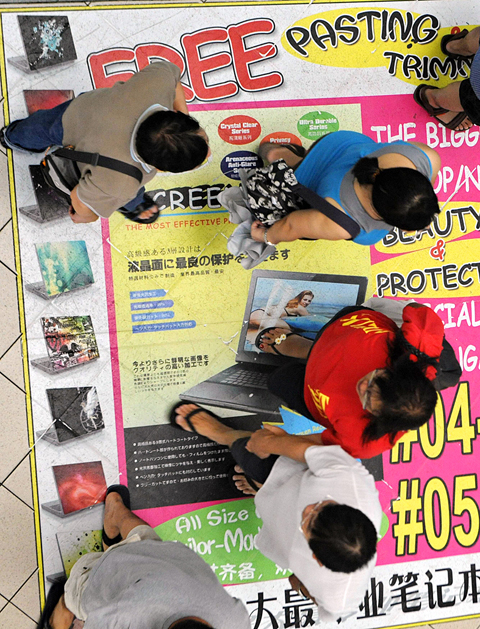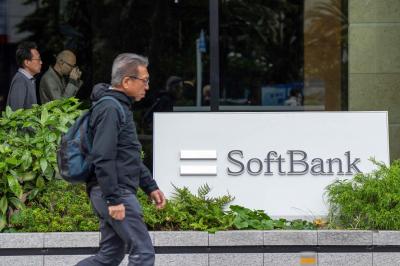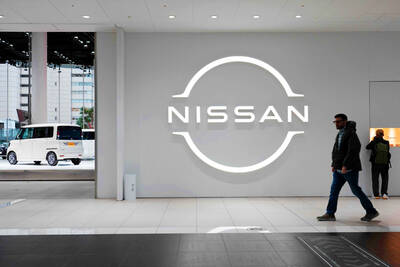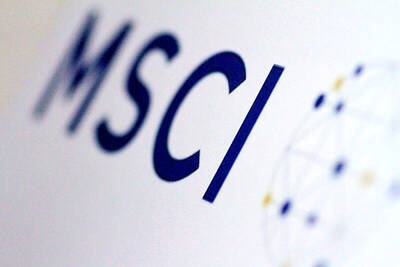Entrepreneur Binod Hariharan has big plans for his southern Indian firm, which develops astrology-based computer software to help users find a suitable spouse or plot their career paths.
Similarly ambitious is Somporn Maneeratanakul, managing director of Thai Software Enterprises, and Nguyen Minh Duc, director of BKIS Security, a Vietnamese company that makes anti-virus programs.
But their dreams of making it big overseas are in danger of being hijacked in the dangerous waters of the global software industry by pirates who make and sell illegal copies of their products right in their home markets.

PHOTO: AFP
While global giants such as Microsoft and computer security firm McAfee are prominent targets of copyright thieves, what is less known is that start-up Asian software companies are notable victims, industry players said.
And unlike the cash-rich industry big boys, these fledgling Asian companies are finding it harder to cope with losses resulting from copyright violations.
Industry group Business Software Alliance (BSA) said in a report this month that software piracy losses reached US$51.4 billion last year, of which US$16.5 billion was incurred in the Asia-Pacific region.
On average, 59 percent of the 900 million pieces of software installed in the Asia-Pacific region were unlicensed, according to the study, which was carried out with industry research firm IDC.
Bangladesh had the highest software piracy rate in Asia, followed by Sri Lanka, Indonesia and Vietnam, with China and India also among the top culprits.
Beyond the revenue losses, the bigger impact is that piracy prevents Asia from producing software giants such as Microsoft’s Bill Gates, analysts said.
“Piracy certainly stifles innovation,” said Tarun Sawney, Asia-Pacific senior director for anti-piracy operations at BSA.
“Why is it that we don’t have any sort of global software company that originated from our part of the world?” he said during an interview at BSA’s regional office in Singapore.
“Yet in the United States, where the laws are very strong and the piracy rate is very low, we have idea, after idea, after idea taking over the whole world — be it Yahoo, be it Facebook, be it a Microsoft operating system,” he said.
Hariharan, chairman and director of astrology software developer Astro-Vision Futuretech Ltd, knows this only too well.
“If we need to survive in the market, we need to ensure that the piracy level of our software is kept down,” he said by telephone from his office in Cochin, a city in India’s Kerala state.
Fighting piracy means diverting precious funds to build protection mechanisms into the firm’s software, Hariharan said.
Installing security mechanisms also complicates the use of the software, requiring more technical support and ultimately making the product more expensive, Hariharan said.
Somporn says one big misconception is that “piracy only impacts large, international software developers.”
Large companies can cope with the revenue losses arising from illegal copying, but for firms that cater to domestic markets, opportunities are limited by piracy, he said in an e-mail.
Another “big myth” is that the piracy rate would fall if software prices were low, said Somporn, whose company employs 30 professionals and claims an annual turnover of around US$1 million.
He said a product made by his company that sells for as little as US$6 is among the most pirated in Thailand.
Nguyen Minh Duc tells a similar story.
Piracy has forced his company to invest additional resources to protect its products.
“This is a drain on our resources, which could otherwise have been used on research and development to develop better products for our customers,” he said.
BSA said the greatest damage to the industry is inflicted by companies — from small and medium enterprises to multinational corporations — using bootleg computer software, rather than by individuals.
“Surprisingly, quite a few listed companies are caught using pirated software. They just have unsophisticated or no software management policies in place,” said Jeffrey Hardee, BSA’s vice president and regional director. “It’s quite shocking.”

PERSISTENT RUMORS: Nvidia’s CEO said the firm is not in talks to sell AI chips to China, but he would welcome a change in US policy barring the activity Nvidia Corp CEO Jensen Huang (黃仁勳) said his company is not in discussions to sell its Blackwell artificial intelligence (AI) chips to Chinese firms, waving off speculation it is trying to engineer a return to the world’s largest semiconductor market. Huang, who arrived in Taiwan yesterday ahead of meetings with longtime partner Taiwan Semiconductor Manufacturing Co (TSMC, 台積電), took the opportunity to clarify recent comments about the US-China AI race. The Nvidia head caused a stir in an interview this week with the Financial Times, in which he was quoted as saying “China will win” the AI race. Huang yesterday said

Japanese technology giant Softbank Group Corp said Tuesday it has sold its stake in Nvidia Corp, raising US$5.8 billion to pour into other investments. It also reported its profit nearly tripled in the first half of this fiscal year from a year earlier. Tokyo-based Softbank said it sold the stake in Silicon Vally-based Nvidia last month, a move that reflects its shift in focus to OpenAI, owner of the artificial intelligence (AI) chatbot ChatGPT. Softbank reported its profit in the April-to-September period soared to about 2.5 trillion yen (about US$13 billion). Its sales for the six month period rose 7.7 percent year-on-year

Nissan Motor Co has agreed to sell its global headquarters in Yokohama for ¥97 billion (US$630 million) to a group sponsored by Taiwanese autoparts maker Minth Group (敏實集團), as the struggling automaker seeks to shore up its financial position. The acquisition is led by a special purchase company managed by KJR Management Ltd, a Japanese real-estate unit of private equity giant KKR & Co, people familiar with the matter said. KJR said it would act as asset manager together with Mizuho Real Estate Management Co. Nissan is undergoing a broad cost-cutting campaign by eliminating jobs and shuttering plants as it grapples

MORE WEIGHT: The national weighting was raised in one index while holding steady in two others, while several companies rose or fell in prominence MSCI Inc, a global index provider, has raised Taiwan’s weighting in one of its major indices and left the country’s weighting unchanged in two other indices after a regular index review. In a statement released on Thursday, MSCI said it has upgraded Taiwan’s weighting in the MSCI All-Country World Index by 0.02 percentage points to 2.25 percent, while maintaining the weighting in the MSCI Emerging Markets Index, the most closely watched by foreign institutional investors, at 20.46 percent. Additionally, the index provider has left Taiwan’s weighting in the MSCI All-Country Asia ex-Japan Index unchanged at 23.15 percent. The latest index adjustments are to